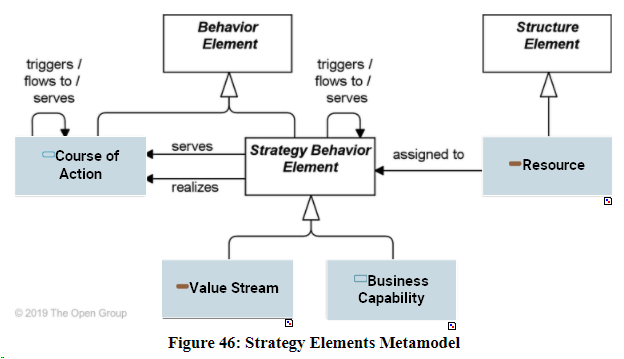IDENTITY - ArchiMate - Strategy
| Description | The strategy elements are typically used to model the strategic direction and choices of an enterprise, as far as the impact on its architecture is concerned. They can be used to express how the enterprise wants to create value for its stakeholders, the capabilities it needs, the resources needed to support these capabilities, as well as how it plans to configure and use these capabilities and resources to achieve its aims |
|---|---|
| References | OpenGroup - ArchiMate - Layer - Strategy |
| Parent Mapping | ArchiMate Mapping |
| Corresponding SysFEAT Domain | ArchiMate - Strategy |

MAPPED ENTITIES
| Framework Concept | Framework Definition | SysFEAT Concept | SysFEAT Definition |
|---|---|---|---|
 Business Capability Business Capability |
 Business Capability
Business Capability |
A Business Capability is a conceptual Capability that benefits to Customers (internal or external) of the enterprise. It expresses an ability to produce Conceptual Outcome Events. A Business Capability is defined by its intended Enterprise Outcome Events and the conditions (Condition Property) under which the production of the Enterprise Outcome Events shall be proceeded. The actual Condition Scale Values for a given Business Capability at different stages of Enterprise Initiatives is given by their exhibition (Exhibited Capability). References: OMG - BACM - Capability OMG - UAF - Capability OpenGroup - ArchiMate - Capability OpenGroup - TOGAF - Definition - Business Capability Business Capability is not directly represented in SysFEAT. Rational: |
|
 Course of Action Course of Action |
 Course of Action
Course of Action |
||
 Resource Resource |
 Business Operating Asset
Business Operating Asset |
Business Operating Assets comprise physical assets which contribute to the production and consumption of Business Outcome Events of the enterprise. This includes Business Agents, their behaviors (Business Behavior: Business Resource Process, Business Resource Interaction Process), References: OMG - UAF - CapableElement OpenGroup - TOGAF - Definition - Solution Building Block OpenGroup - TOGAF - Guide - Solution Building Blocks |
|
 Value Stream Value Stream |
 Value Stream
Value Stream |
Value Streams are used to frame the Conceptual Operating Model of the enterprise: they describe how the enterprise shall operate, at the conceptual level, and helps chunking responsibilities between Conceptual Agents (Operating Domain or Business Function) . In the EA context, a Value Stream is a conceptual Action Process that represents an overarching perspective of the organization's processes aiming at producing Conceptual Outcome Events. The focus is on shaping and understanding the functional relationships and roles within the enterprise : its functional division of labor. This is not to be confused with Value Stream Mapping (VSM) which is focused on Lean optimization and is addressed with the concept of Business Process (see the Organization & Processes domain). A Value Stream is performed by Conceptual Agents who produce Conceptual Outcome Events. It is depicted as a sequence of Value Stream Stages, controlled by events and conditions. Value Stream Activitys are carried out by the involvment of Conceptual Agents as participants in the Value Stream. During its course of action, a Value Stream consumes, produces or stores Business Objects. 1) It may read or write Domain Assets in its Business Object Store. 2) It may receive Domain Assets at its boundary: reacted to Business Outcome Events. 3) It may produce Domain Assets at its boundary: produced Business Outcome Events. The course of actions of a Value Stream is constrained by the application of rules ( Conceptual Rule Enforcement) that define what is allowed and not allowed to do. There are traditionnaly two kinds of Value Streams: 1) Development development Value Streams define all of the actions, both value-creating and nonvalue-creating, required to bring a Product from concept to launch. 2) Operational Value Streams define define all of the actions, both value-creating and nonvalue-creating, required from order to delivery. These include actions to process information from the Customer and actions to transform the product on its way to the Customer. References: Lean.org - Value Stream OMG - BACM - ValueStream OMG - BPMN - Process OMG - UAF - Operational Activity OMG - UAF - OperationalActivity OpenGroup - ArchiMate - Value-Stream OpenGroup - TOGAF - Definition - Value Stream SAFe© - Value Stream Wikipedia - Value Stream |